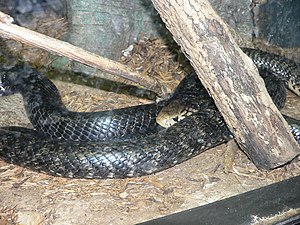Black and white hat snake
| Black and white hat snake | ||||||||||||
|---|---|---|---|---|---|---|---|---|---|---|---|---|

Black and white hat snake ( Naja melanoleuca ) |
||||||||||||
| Systematics | ||||||||||||
|
||||||||||||
| Scientific name | ||||||||||||
| Well melanoleuca | ||||||||||||
| Hallowell , 1857 |
The black and white hat snake ( Naja melanoleuca ) (sometimes also called black and white cobra , white lipped cobra or forest cobra ) belongs to the genus of real cobras ( Naja ) within the family of poisonous snakes ( Elapidae ).
ID
Adult black and white hat snakes reach a length of 150 to 200 centimeters. In exceptional cases, the snake can grow up to 300 centimeters and more. The head stands out slightly from the rest of the body. It's relatively small for a cobra. The color can vary considerably. The form that occurs in South Africa , for example, is brown to brownish gray; the one from West Africa is predominantly black. The abdomen usually has a yellowish or whitish cream color, sometimes with black spots. The scales are soft and shiny.
The snake is generally considered to be very aggressive. When threatened, it straightens its front body. Your neck region then becomes a broad shield.
Subspecies
The following subspecies have been described:
- Well melanoleuca melanoleuca ( Capocaccia , 1961)
- Naja melanoleuca aurata ( Stucki-forehead , 1979)
- Well melanoleuca subvulva ( Laurent , 1955)
Occurrence
The snake prefers moist habitats and is common in moist forest areas. They are often found in semi-aquatic habitats. The snake is also found in rice paddies, in granaries or garbage dumps where it can find plenty of food. Piles of rock, termite mounds and holes in the ground serve as shelter. The subfulva subspecies occurs in drier regions. Countries where the black and white hat snake occurs include Ethiopia , Angola , Benin , Burkina Faso , Burundi , Democratic Republic of the Congo , Ivory Coast , Gabon , Gambia , Ghana , Guinea , Guinea-Bissau , Cameroon , Kenya , Liberia , Malawi , Mali , Mozambique , Niger , Nigeria , Rwanda , Republic of South Africa , São Tomé , Zambia , Senegal , Sierra Leone , Zimbabwe , Somalia , Sudan , Tanzania , Togo , Chad , Uganda and the Central African Republic . They are also often found on Bioko and in Río Muni in Equatorial Guinea .
food
The snake prefers to feed on smaller mammals (e.g. rats, mice), birds, lizards, other snakes, toads and frogs. Fish are also part of the prey, which they catch as a good swimmer in the water.
Reproduction
Well -species reproduce oviparously . In freedom they have a life expectancy of around 12 years. On average, the hat snake lays 10 to 15 eggs. The eggs are about 60 mm × 30 mm in size. The eggs are preferably hidden in hollow trees, holes in the ground or in fallen leaves. The young hatch after about 70 to 80 days. At this stage, they are 35 to 40 inches long.
toxicology
The poison of the black and white hat snake is neurotoxic . The symptoms are paralysis. The poison unfolds its effect in the area of the synapses . The poison of the black and white hat snake is considered to be the second most poisonous of all African cobras after that of the Cape cobra .
literature
- Martin C Stucki-Stirn, Snake report 721: A comparative study of the herpetological fauna of the former West Cameroon , Herpeto-Verlag, 1979
- Sylvia A. Johnson, Cobras , Lerner Publications, 2006, ISBN 978-1-57505-871-9
Web links
- Well melanoleuca in The Reptile Database
- Well melanoleuca in the Integrated Taxonomic Information System (ITIS). Retrieved January 4, 2012.
swell
- ^ Richard Mastenbroek: Forest Cobra (Well melanoleuca). Archived from the original on March 18, 2010 ; Retrieved December 8, 2013 .
- ↑ White-lipped cobra, forest cobra, Naja melanoleuca
- ↑ Biodiversidad. Reptiles Well melanoleuca
- ↑ Well melanoleuca. Retrieved December 8, 2013 .
- ↑ Cobras of the genus Naja
- ↑ Well sp. African neurotoxic
